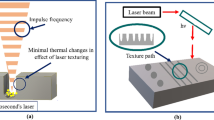Conclusions
-
1.
With the pulse width τp decreasing from 8.0 to 1.5 msec, the microhardness of preliminarily hardened high-speed steels after laser hardening at temperatures close to the solidus temperature Ts first increases to the maximal value (H 1120-1150) at τp=3 msec, then it decreases. This is due to the occurrence of disperison hardening of different degrees and the formation of different amounts of residual austenite in the structure of the steels.
-
2.
With τp=3 msec there is practically no residual austenite in steels whereas after laser hardening by pulses with τp=1.5 and 8.0 msec the structure contains about 15% γ-phase.
-
3.
After laser hardening at temperatures close to TS the structure of preliminarily hardened high-speed steels contains secondary carbides whose number per unit volume depends on τp. The maximal amount of secondary carbides (11.905–12.893)1013 mm−3 forms with τp=3
-
4.
Secondary carbides segregate during the process of laser tempering occurring in laser heating to the temperature of the onset of α→γ transformation, and they do not have enough time to dissolve completely during the process of laser austenitization.
-
5.
The maximal increase to tool life (3–5 times) is found after laser hardening at TS with pulse width of 3 msec.
Similar content being viewed by others
Literature cited
V. S. D'yachenko, G. N. Tverdokhlebov, and A. A. Korosteleva, "Special features of laser heat treatment of high-speed steel tools," Metalloved. Term. Obrab. Met., No. 9, 25 (1984).
V. S. D'yachenko, "Special features of the structure and properties of high-speed steels after laser treatment," Metalloved. Term. Obrab. Met., No. 8, 50 (1985).
S. A. Saltykov, Stereometric Metallography [in Russian], Metallurgiya, Moscow (1976).
V. N. Gridnev, Yu. Ya. Meshkov, S. P. Oshkaderov, and V. I. Trefilov, The Physical Foundations of Electrothermal Strengthening of Steel [in Russian], Naukova Dumka, Kiev (1973).
D. A. Mirzaev, S. E. Korzunov, V. M. Schastlivtsev, and I. L. Yakovleva, "The effect of the cooling rate in hardening on the amount of residual austenite and on the hardness of carbon steels," Fiz. Met. Metalloved.,56, No. 5, 1033 (1983).
Additional information
Kharkov Aviation Institute. Translated from Metallovedenie i Termicheskaya Obrabotka Metallov, No. 9, pp. 11–14, September, 1986.
Rights and permissions
About this article
Cite this article
D'yachenko, V.S. The effect of the regimes of pulsed laser treatment on the structure and properties of high-speed steels. Met Sci Heat Treat 28, 632–636 (1986). https://doi.org/10.1007/BF00742740
Issue Date:
DOI: https://doi.org/10.1007/BF00742740




